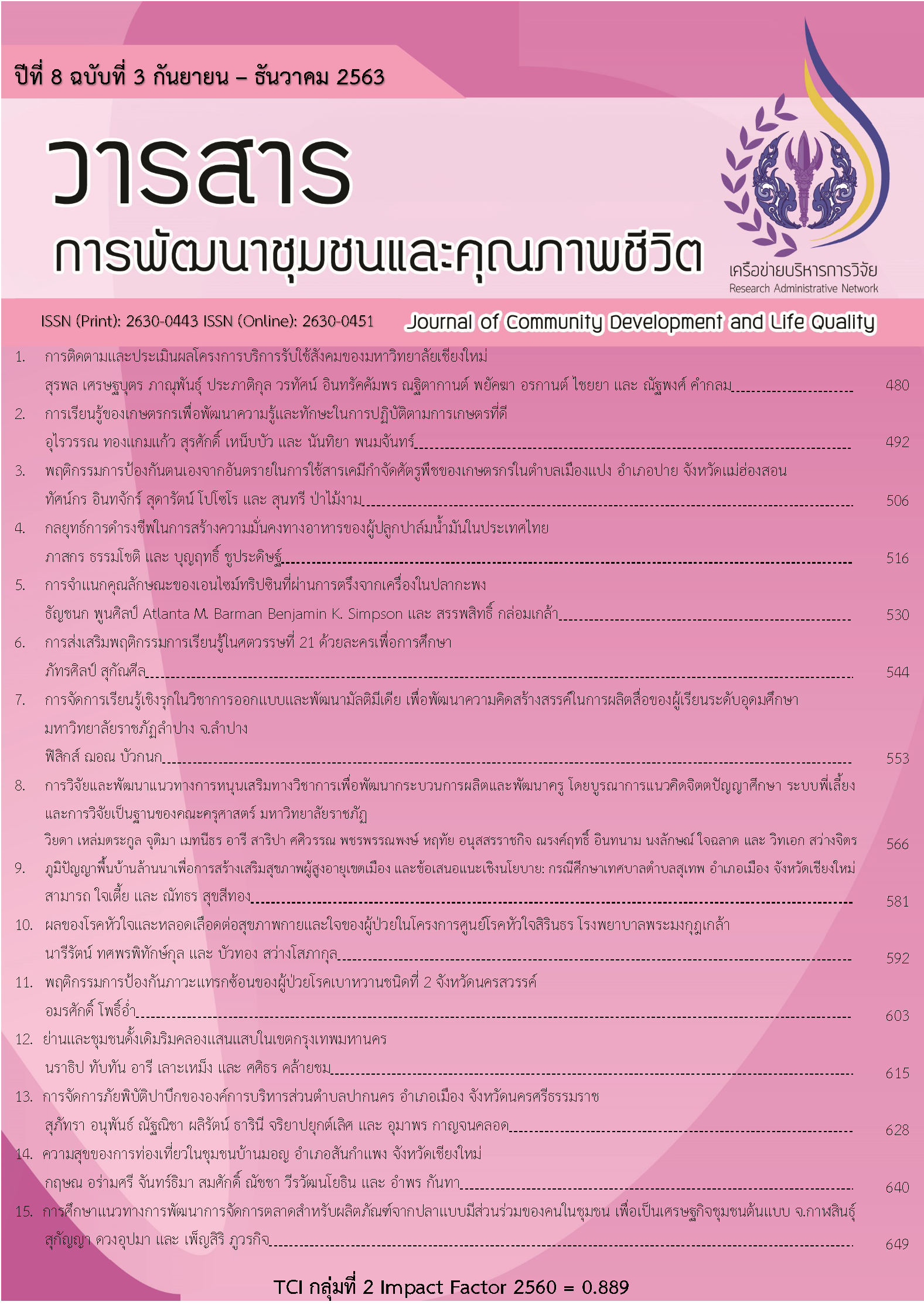การจัดการเรียนรู้เชิงรุกในวิชาการออกแบบและพัฒนามัลติมีเดีย เพื่อพัฒนาความคิดสร้างสรรค์ในการผลิตสื่อของผู้เรียนระดับอุดมศึกษา มหาวิทยาลัยราชภัฏลำปาง จ.ลำปาง
Main Article Content
บทคัดย่อ
การวิจัยนี้ต้องการพัฒนาความคิดสร้างสรรค์ของผู้เรียนสำหรับใช้ในการสร้างสื่อโดยเฉพาะ ซึ่งรูปแบบการจัดการเรียนรู้เชิงรุกเพื่อพัฒนาความคิดสร้างสรรค์ผู้เรียนที่ได้เรียกว่า รูปแบบเครื่องบินรบ ซึ่งใช้ปัญหาเป็นฐานมี 5 ขั้น 1) พบปัญหา 2) โบยบินไปกับปัญหา 3) เลือกคำตอบ 4) ตรวจสอบคำตอบ 5) ได้คำตอบที่ดีที่สุด ทำการศึกษาผลการใช้รูปแบบการจัดการเรียนรู้เชิงรุก เพื่อทราบความสัมพันธ์ของการจัดการเรียนรู้เชิงรุกกับการพัฒนาความคิดสร้างสรรค์ โดยใช้แผนการวิจัย static group comparison ทำการทดลอง 2 กลุ่มเปรียบเทียบผล กลุ่มตัวอย่างคือนักศึกษา 60 คน ที่เรียนวิชาการออกแบบและพัฒนามัลติมีเดีย ในปี 2/2560, 2/2561 ที่คณะครุศาสตร์ มหาวิทยาลัยราชภัฏลำปาง วิเคราะห์ข้อมูลโดยใช้ค่าเฉลี่ย ค่าเบี่ยงเบนมาตรฐาน t-test ค่าสหสัมพันธ์ Pearson ผลการใช้รูปแบบพบว่า กลุ่มตัวอย่างผลิตมัลติมีเดียเชิงสร้างสรรค์มีนัยสําคัญทางสถิติระดับ 0.05 ผลความสัมพันธ์ของการจัดการเรียนรู้เชิงรุกกับการพัฒนาคิดสร้างสรรค์ผู้เรียนมีความสัมพันธ์กัน ค่าสหสัมพันธ์ 0.653
Article Details
กองบรรณาธิการขอสงวนสิทธิ์ในการตรวจและแก้ไขบทความที่เสนอเพื่อตีพิมพ์ในวารสารการพัฒนาชุมชนและคุณภาพชีวิต
บทความหรือข้อความคิดเห็นใด ๆ ที่ปรากฏในวารสารการพัฒนาชุมชนและคุณภาพชีวิต เป็นวรรณกรรมของผู้เขียนโดยเฉพาะคณะผู้จัดทำไม่จำเป็นต้องเห็นด้วย และไม่ใช่ความรับผิดชอบของมหาวิทยาลัยและคณะผู้จัดทำ / บรรณาธิการ
เอกสารอ้างอิง
Bore, A. 2006. Bottom-up for creativity in science? A collaborative model for curriculum and professional development. Journal of Education for Teaching 32(4): 413–422.
Casakin, H.P. 2007. Metaphors in design problem solving: Implications for creativity. International Journal of Design 1(2): 23-35.
Chaijaroen, S., I. Khanjug, C. Samat and P. Kwangmuang. 2016. Design and development of learning innovation integrated philosophy of the sufficiency economy moral and Thai values for balance and sustainable development on the topic of homegrown vegetable for fourth grade students. Journal of Industrial Education 15(2): 110-117. (in Thai)
Coholic, D., M. Eys and S. Lougheed 2012. Investigating the effectiveness of an arts-based and mindfulness-based group program for the improvement of resilience in children in need. Journal of Child and Family Studies 21(5): 833–844.
Cremin, T. 2006. Creativity, uncertainty and discomfort: Teachers as writers. Cambridge Journal of Education 36(3): 415–433.
Freund, P. and H. Holling. 2008. Creativity in the classroom: A multilevel analysis investigating the impact of creativity and reasoning ability on GPA. Creativity Research Journal 20(3): 309–318.
Golden, C.J. 1975. The measurement of creativity by the stroop color and word test. Journal of Personality Assessment 39(5): 502–506.
Greene, M. 2009. Fostering creativity in the classroom: Effects of teachers’ epistemological beliefs, motivation, and goal orientation. Journal of Creative Behavior 43(3): 192–208.
Hsu, A., S. Hou and H. Fan. 2011. Creative self-efficacy and innovative behavior in a service setting: Optimism as a moderator. The Journal of Creative Behavior 45: 258–272.
Jeffrey, B. 2006. Creative teaching and learning: Towards a common discourse and practice. Cambridge Journal of Education 36(3): 399–414.
Lee, I.R. and K. Kemple. 2014. Preservice teachers’ personality traits and engagement in creative activities as predictors of their support for children’s creativity. Creativity Research Journal 26: 82–94.
Mathisen, G.E. and K.S. Bronnick. 2009. Creative self-efficacy:An intervention study. International Journal of Educational Research 48: 21–29.
Memmert, D. 2007. Can creativity be improved by an attention-broadening training program? An exploratory study focusing on team sport. Creativity Research Journal 19(2–3): 281–291.
Thomson, P. and E. Sanders. 2010. Creativity and whole school change: An investigation of English headteacher practices. Journal of Educational Change 11: 63–83.


